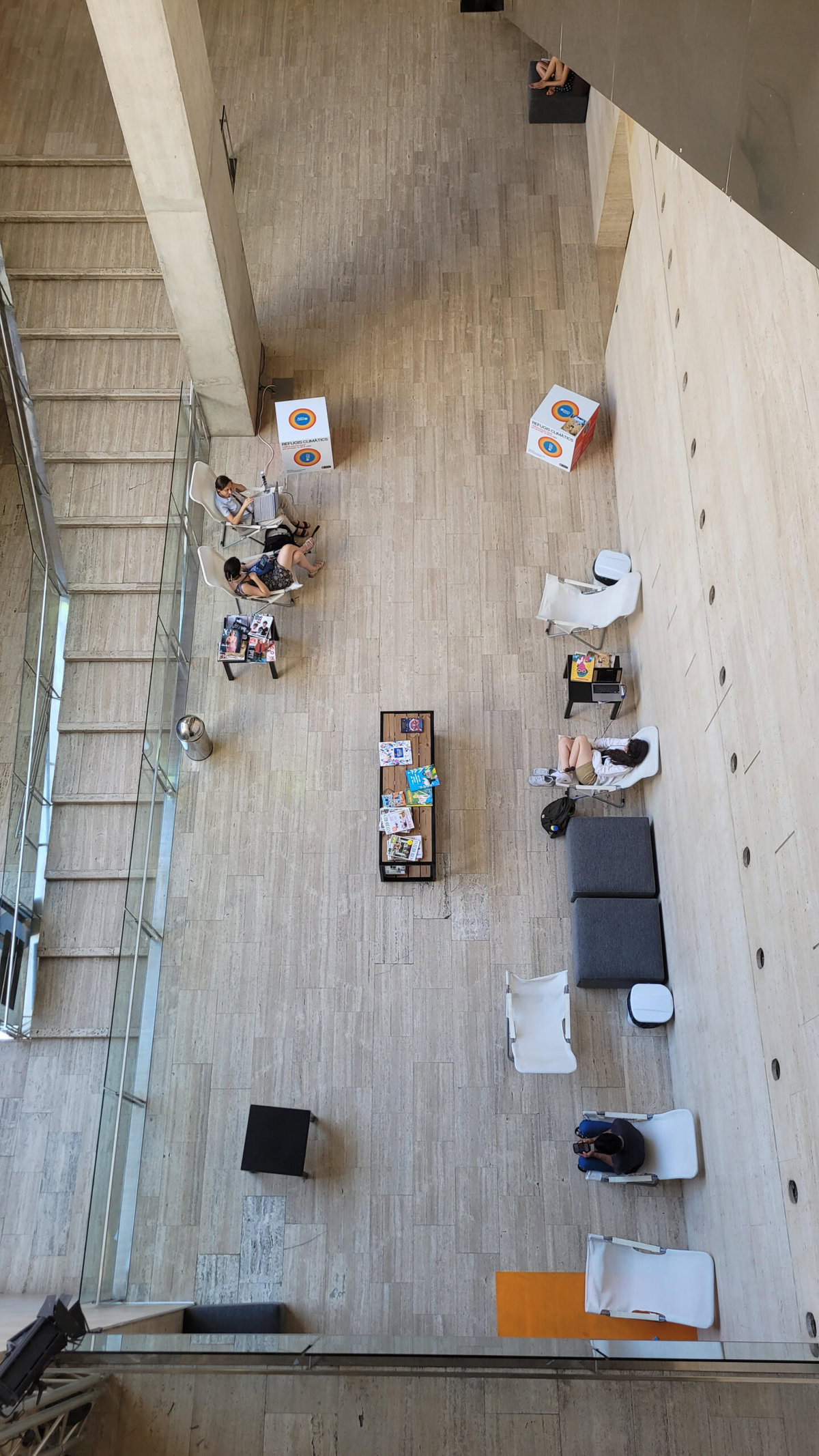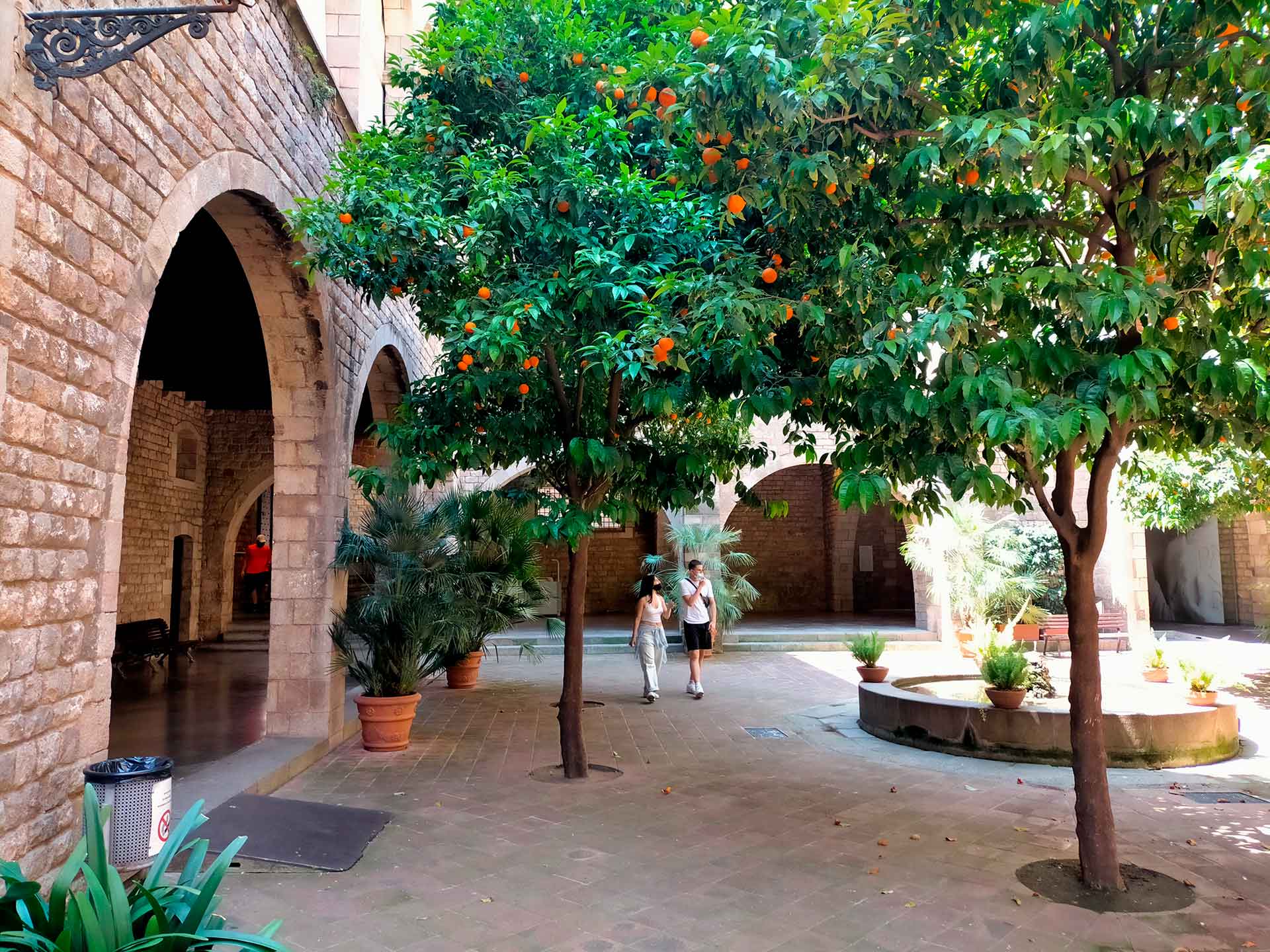In El Raval, the historic district in the heart of Barcelona, the sprawling 19th-century building that’s now home to the Centre of Contemporary Culture of Barcelona (CCCB) began its life as Casa de la Caritat, a house of charity providing shelter to the most vulnerable members of society. Now, the CCCB is once again a place of refuge for those in need, as part of Barcelona’s growing climate shelter network.
The network began with 70 locations in 2020 and expanded to 368 last summer, as temperatures in Barcelona reached 40° Celsius (104° Fahrenheit), making July 2024 the hottest month since the city started keeping records 110 years ago. While temperatures are rising globally, cities can be as much as 15° Celsius hotter than surrounding rural areas. This is referred to as the urban heat island effect, which is caused in large part by our built environment — materials like concrete and cement absorb and retain heat, while tall buildings trap it near the surface and block ventilation.
Heat doesn’t affect everyone equally — climate vulnerabilities are influenced by an individual’s level of exposure, level of sensitivity and capacity for adaptation. Children, the elderly, people with pre-existing conditions and low-income communities are particularly at risk of heat-related illnesses. “These are not static things that you’re born with, they are very political and depend on historical, material, socioeconomic circumstances,” says Ana Terra Amorim-Maia, researcher at the Basque Center for Climate Change in Bilbao. She sees climate shelters as a relatively simple urban solution that can tackle all three factors at once: “They can be real lifesavers because they can be placed in areas that are more exposed to extreme heat or cold. They can be targeted at populations that are more sensitive to climate change, and help people cope with climate hazards.”
In Barcelona, climate shelters are integrated into the city’s existing public infrastructure, expanding the services of civic centers, libraries, museums, parks and gardens. This begs the question: Why bother setting up a climate shelter network at all, when these spaces are already open to the public? “It’s important because sometimes people don’t feel like they can go there just to be comfortable,” says Mar Campanero i Sala from the City Council’s Office for Climate Change and Sustainability. “They feel they have to find an excuse, and it’s not necessary.”
Establishing an official network also means shelters, which are marked with a symbol and listed in an interactive map on the city’s website, have to fulfill minimum requirements: Besides keeping a maximum temperature of 26° Celsius (79° Fahrenheit), they are free of charge, accessible for people with disabilities, offer comfortable seating and free drinking water.
This is a crucial part of creating an effective network of climate shelters, says Amorim-Maia: “What I see around the world is cities calling any of their public spaces a climate shelter without doing modifications,” she says. “You have funicular stations that barely have room to stand, they don’t offer any water, they don’t have anything. But they have a sticker saying that they’re a climate shelter.”
Weighed down by negative news?
Our smart, bright, weekly newsletter is the uplift you’ve been looking for.
With an increase in temperature extremes, growing urbanization and an aging population, heat is a growing health risk, and climate shelters — often referred to as “cooling centers” in the US and UK — are becoming increasingly common. Paris was one of the first cities to establish a city-wide network of “cool islands,” now joined by cities ranging from Buenos Aires to New York, while Madrid’s residents have started creating their own climate shelters as the city’s plans have failed to materialize.

Generally, mortality risk due to heat is increasing more steeply in Europe than the US because air conditioning is much less common, and in Spain 6.2 percent of premature deaths can be attributed to heat, compared to 0.87 percent in the US. The climate shelters in Barcelona are meant to offer not only refuge from outdoor heat, but also from uncomfortably warm homes, which can be more dangerous long-term.
When we think of the impact heat has on our bodies, we usually consider the most immediate effects, ranging from the annoyance of a heat rash all the way to potentially deadly heat strokes. However, cumulative health impacts are a much bigger, and less obvious, issue. Temperature extremes — whether hot or cold — put additional stress on our bodies and can worsen cardiovascular, mental, respiratory and diabetes-related chronic conditions. High temperatures also impact our behavior, causing increased anxiety, depression and aggression and further impact our health through environmental effects, such as decreases in the quality and quantity of food and water.
Based on data from 1991 to 2018, over a third of global heat-related deaths can be attributed to climate change, with increased mortality evident on every continent. Most heat-related health issues and deaths can be prevented by avoiding prolonged heat exposure, and climate shelters have been shown to reduce both the physical and psychological strain caused by extreme heat. In general, societal climate adaptations since the turn of the century are having a significant impact: While heat caused over 47,000 deaths in Europe in 2023, the number would have been 80 percent higher if the continent had experienced the same temperatures in 2000.
Climate shelters are designed to mitigate the worst health outcomes, but there is not much they can do about long-term cumulative effects. These can be addressed in part by cooling the entire city with the help of green areas and changes in urban design, says Andréanne Chu Breton-Carbonneau, a doctoral researcher at the Barcelona Laboratory for Urban Environmental Justice and Sustainability who researches health equity impacts of urban climate adaptations. But working with marginalized communities is just as crucial. “Cooling is important when we’re thinking about heat. But part of what makes certain communities particularly at risk isn’t just because it got very hot all of a sudden. There are other underlying conditions like their housing, infrastructure, that all just lead to the point that it gets hot, and their bodies can’t keep up with it,” says Chu Breton-Carbonneau. “I see it more as a question of ‘How are we supporting these historically marginalized communities when it’s not so hot?’”
These intersecting climate vulnerabilities can also make access to climate shelters more difficult, says Amorim-Maia. As her 2023 study of the low-income migrant neighborhood La Prosperitat showed, many of the people most vulnerable to heat were unaware of the city’s climate shelters, and more open to using outdoor public spaces to cool down, highlighting the need for highly localized, community-led approaches. “There are structural barriers,” says Amorim-Maia. ”It’s hard for a family with several members to move everyone to the climate shelter. Or they might not feel welcome if they go to the library, where you’re supposed to be quiet, and start speaking in Arabic. The climate shelters are going to have to be varied in the kinds of activities that they offer.”
The CCCB has adapted different parts of their building for use as a climate shelter, including indoor and outdoor spaces, as well as offering free interactive activities for families. Some of the biggest challenges have been balancing their cultural program with providing areas where people can rest, as well as staying open in August, when most of the staff is on vacation, explains Pilar Soldevila i García, deputy managing director of the CCCB.

This has been an ongoing criticism of the climate shelter network — since many public institutions in Barcelona close on weekends and in August, there are far fewer climate shelters available at the times when people need them most. “That obviously poses a very clear gap in their ability to mitigate public health challenges,” says Chu Breton-Carbonneau.
In order to address this, the network has now expanded to include places like sports clubs, municipal markets, churches and shopping malls. For 2025, they are also planning to include smaller shops as “micro shelters,” where people can pop in for a quick break, a sip of water and directions to the nearest larger shelter, says Campanero i Sala: “We have to adapt to this. It’s difficult to find spaces that are open in August, but we are working on it.”
With this expanded network, 98 percent of the population now lives within a 10-minute walk from a shelter, and 68 percent within a five-minute walk. The goal for 2030 is to strategically expand the network until nobody is more than five minutes away from a shelter. The accessibility of shelters on the hottest days also improved in 2024, with 168 shelters open on Sundays in August, so that 89 percent of the population was still within a 10-minute walking distance.
The city is also working on spreading awareness of the network — in 2023, just over a third of Barcelonans were aware of it. This is a long-term project that is still evolving and growing, says Campanero i Sala: “It’s one thing that we try to explain when people criticize the network — it’s not perfect. It’s not for now. We are working on it, we are improving, and the goal is that it will be perfect when it really will be necessary. We are preparing for a future situation.”
Amorim-Maia agrees that Barcelona’s forward-thinking climate adaptations mean it faces a lot of scrutiny: “I feel like Barcelona is heavily criticized because it is at the forefront, because it is a pioneering city. It’s not perfect, but I also need to acknowledge all of the effort. It is improving every year.”
The post The Welcoming Climate Shelters of Barcelona appeared first on Reasons to be Cheerful.




